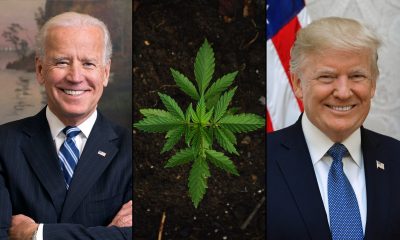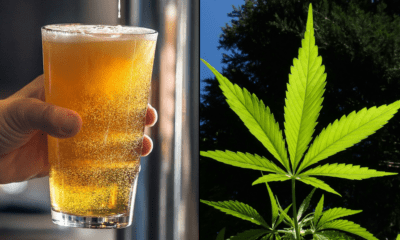Politics
‘Now Is The Time’ For The Feds To Shape Psychedelics Policy, RAND Corporation Report Says

Amid growing interest in the therapeutic value of psychedelics and efforts by some state and local jurisdictions to reform laws around the drugs, a new report from the RAND Corporation says that “now is the time” for federal policymakers to decide how to regulate psilocybin and other substances.
The 161-page report, Considering Alternatives to Psychedelic Drug Prohibition, was published by RAND on Thursday. It’s intended to help provide context about use as well as possible regulatory pathways for policymakers in the U.S. and internationally.
Despite federal prohibition, the new report notes, since 2019 more than two dozen localities have deprioritized the enforcement of laws around psychedelics, “generally making it a low or the lowest priority for law enforcement officials.” Voters in Oregon have also legalized supervised use of psilocybin, while Colorado voters legalized not only facilitated psilocybin use but also personal possession and production of psilocybin, DMT, non-peyote mescaline and other psychedelics.
Other states are also eyeing changes to psychedelics regulation.
“Now is the time for federal policymakers to decide what they want these supply models to look like and to start taking action,” the RAND report says. “Or, if they prefer a patchwork of state policies—possibly including those that allow for commercial supply and promotion—they can do nothing and just watch the industry grow.”
“If that happens,” it adds, “it can be difficult to make major changes to supply or regulations, but that will depend on the size and political power of the industry that has taken root.”
Though many reforms so far have been focused on research into psychedelics and how to eventually allow legal access, analysts noted that “if moves to expand nonclinical supply do not go well (e.g., they are poorly regulated or there are a series of high-profile negative events related to the use of psychedelics), they could create a backlash that may have a chilling effect on the research.”
“Looking at what happened with clinical research on psychedelics after the 1960s,” the report points out, “this is not an idle concern.”
"The current situation with psychedelics reminds me of where we were with cannabis policy 12 years ago," says RAND’s @BeauKilmer, lead author of the report.
"Now is the time for federal policymakers to decide if they want to shape these policy changes or stay on the sidelines."
— RAND (@RANDCorporation) June 27, 2024
Among the document’s many takeaways is that while the effort to end psychedelics prohibition might resemble the fight to legalize marijuana in some regards, the way people use the substances differ in important ways.
For example, frequent use of psychedelics appears to be rather uncommon. Unlike with marijuana and other drugs, the report notes, infrequent users account for the bulk of psychedelic use.
“A major takeaway from our analyses is the extent to which to which infrequent users drive the market for psychedelics,” authors wrote. “For cannabis, it is negligible: Those who reported using five or fewer days in the past month account for about 5 percent of the total use days in the past month. For psychedelics, that figure is closer to 60 percent.”
Data for the quantitative analysis came from the 2023 RAND Psychedelic Survey, which was supplemented by secondary sources, while qualitative data “are based on 18 structured interviews with individuals from the United States and abroad, including legal experts, policy advocates, regulators, clinical researchers, mental health care providers, and representatives from organizations working in the emerging psychedelics industry,” the report says.
Authors estimated the size of the psychedelics market is two orders of magnitude smaller than the marijuana market. Measured in total number of use days, the number of use days “in the past month for cannabis was on the order of 650 million whereas the comparable figure for hallucinogens was closer to 7 million.”
“It is no surprise that the figure for cannabis is much higher than it is for hallucinogens,” authors wrote, “but thinking about this in terms of use days provides more insight about the relative size of these markets.”
Among psychedelics themselves, psilocybin was the most frequently used by U.S. adults, with about 3.1 percent of people reporting past-year use and 0.9 percent reporting use in the past month. By comparison, past-year and past-month use rates for cannabis were about 30 percent and 20 percent, respectively.
Moreover, among those who reported using psilocybin in the past year, nearly half (47 percent) reported microdosing the drug the last time they used it.
Largely because of the comparatively infrequent use of psychedelics, the report notes that price “may matter less as a regulatory tool” than it does with other substances.
Psychedelic substances, such as psilocybin mushrooms and LSD, have long been touted as holding promise for treating various mental health conditions. The past decade has seen another round of enthusiasm for this hope.
— RAND (@RANDCorporation) June 27, 2024
“Given the infrequent purchases, price changes might not matter as much as they do for other substances that are consumed frequently, even daily, such as alcohol and cannabis,” it says.
Authors underscore that policymakers have choices beyond simply “legal” or “outlawed” when it comes to psychedelics, noting” “There are many supply policy options between prohibition and legalizing production and sale by for-profit companies.”
As for possible risks of psychedelic use, RAND says that despite centuries or millennia of use by indigenous peoples, published scientific literature “is limited in its understanding of the consequences of using psychedelics and preventing and mitigating adverse events.” However, that’s slowly changing.
“Guidelines for preventing and mitigating adverse events related to use in non-Indigenous settings are beginning to take shape,” the report says. “These include public education about the effects and potential risks, standards for informed consent, and expanded training for first responders and health care professionals.”
Policymakers should include indigenous groups in discussions about how to regulate psychedelics, it adds, in part because of their historical experience with supervised use of spiritual medicines and in part because of “how policy changes could affect the availability of these substances for religious and spiritual uses.”
Authors also urged officials to consider aspects like supervised and facilitated use.
“Although almost all of those who currently use psilocybin do so without supervision from a formal facilitator or shaman, there is demand for facilitation, trip-sitters, and retreats, and it could increase after a policy change,” the report says.
“Policymakers need to decide whether they want to promote or create incentives for people to use facilitators, and, if so, whether any type of regulation will be imposed (e.g., licensing requirements; liability insurance),” it continues. “Either way, there will be some facilitators willing to provide these services outside what is legally allowed (this has long been happening and may now be on the rise) and policymakers—and possibly voters—will need to decide whether it will be a low or high priority to spend enforcement resources on suppressing this group.”
In general, RAND authors said it’s “critical to improve the data infrastructure on psychedelics to better support policy analyses.”
“When developing this report, it became clear how little has been published about the markets and patterns of use for many psychedelics—especially psilocybin,” they wrote. “This gap creates challenges for projecting the consequences of a possible policy change.”
There are outstanding needs for further research, they continued, noting that the Substance Abuse and Mental Health Services Administration (SAMHSA) could add questions to its annual questionnaire to include “prevalence and frequency of use about psychedelics,” for example to better study microdosing behavior, costs, intention of use, the role of supervision and other details.
“Another example,” authors said: “There is a need to conduct qualitative research (ideally longitudinally) with those who use psychedelics and those who produce and distribute these substances in legal or illegal settings.”
The RAND report emphasizes that it should not be interpreted “as a rejection or endorsement of traditional supply prohibition or its alternatives.”
“The goal is simply to provide information to ground policy debates and to highlight multiple policy options that could be considered,” it says. “Comparing these alternatives with prohibition and with one another is a challenging task. Perspectives on psychedelics policy will be shaped by such factors as an individual’s values, their preferences for risk, basic facts about these markets, and the consequences of using these substances.”
The RAND Corporation, which is funded in large part by the U.S. government, is a nonprofit think tank and public consulting firm that’s helped advise policymakers on various issues. In 2021, for example, it released a government-funded report concluding that past cannabis use had relatively little impact on U.S. Army recruits’ overall performance.
Researchers at RAND also contributed to a 2018 report that found that past-month marijuana consumption decreased by a small but statistically significant amount among 8th and 10th grade students in Washington State following legalization there.
The new paper on alternatives to psychedelics prohibition comes amid what a United Nations (UN) annual drug report dubbed a “psychedelic renaissance” in the U.S. and globally, pointing to “a renewed interest in the therapeutic use of different psychedelic substances.”
The UN report was published just days after a separate, human rights-focused UN document urged member states to abandon the war on drugs. Tlaleng Mofokeng, the UN’s special rapporteur on the right to health, urged member nations in the new report to end the war on drugs and instead enact harm-reduction policies such as decriminalization, supervised consumption sites, drug checking and widespread availability of overdose reversal drugs like naloxone—while also moving toward “alternative regulatory approaches” for currently controlled substances.
Among that report’s recommendations was that countries “decriminalize the use, possession, purchase and cultivation of drugs for personal use and move toward alternative regulatory approaches that put the protection of people’s health and other human rights front and centre.”
A report last year from an international coalition of advocacy groups, meanwhile, also found that global drug prohibition has fueled environmental destruction in some of the world’s most critical ecosystems, undermining efforts to address the climate crisis.
And a year ago, UN special rapporteurs in a separate report said that “the ‘war on drugs’ may be understood to a significant extent as a war on people.”
“Its impact has been greatest on those who live in poverty,” they said, “and it frequently overlaps with discrimination directed at marginalised groups, minorities and Indigenous Peoples.”
In 2019, the UN Chief Executives Board (CEB), which represents 31 UN agencies including the UN Office on Drugs and Crime (UNODC), adopted a position stipulating that member states should pursue science-based, health-oriented drug policies—namely decriminalization.
Biden Vs. Trump On Marijuana: Where The Candidates Stand Heading Into The 2024 Election
Photo elements courtesy of carlosemmaskype and Apollo.
















